17. Jan 2019 - DOI 10.25626/0093
Raluca Grosescu is Researcher at the University of Bucharest and Associate Research Fellow at Exeter University (UK). She is author of Les communistes dans l’après-communisme. Trajectoires de conversion politique de la nomenklatura roumaine après 1989 (Paris: Hichel Houdiard, 2012) and the co-editor of Transitional Criminal Justice in Post-Dictatorial and Post-Conflict Societies (Cambridge: Intersentia, 2015). She is currently working on a global history of trials held against former authoritarian leaders in Eastern Europe and Latin America and she is the principal investigator of the project “Transitional Justice in Romania in Global Perspective”, funded by the Romanian Ministry of Research (project PN-III-P1-1.1-TE-2016-1063). She holds a PhD in political science from the University of Paris Ouest Nanterre.
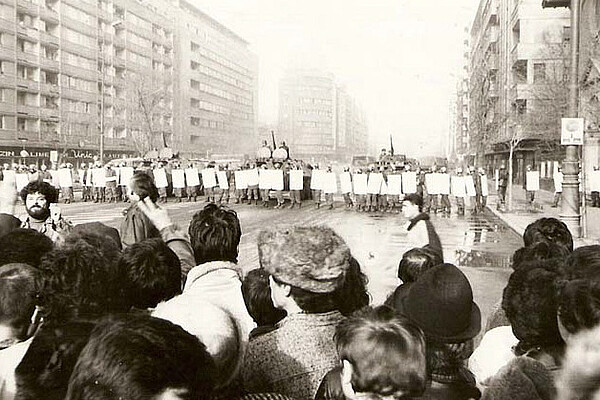
Almost thirty years after the collapse of the communist regime in Romania, the exact details of the violent events that unfolded in December 1989 remain one of the most contentious chapters in the country’s recent history. Various trials and investigative reports have clarified the responsibility for the violent suppression of anti-communist demonstrators between 16 and 22 December. Yet, the causes of the violence that followed Nicolae Ceauşescu’s fall on 22 December and created the overwhelming majority of victims remain unclear. A recent indictment and a trial to begin in 2019 have the potential to produce new insights into these events.
In December 2018, Romania’s prosecutor general charged former president Ion Iliescu and two other prominent figures from the National Salvation Front (NSF), the political organization that assumed power after the Ceauşescu’s flight from Bucharest, for crimes against humanity. They are accused of having orchestrated a deliberate misinformation campaign between 22 and 30 December 1989 about the existence of armed supporters of Ceauşescu (the so-called “terrorists”) and of having allowed dangerous military manoeuvres in a bid to foment political chaos and ensure control over state institutions. These acts, if indeed committed, resulted in a “military diversion” operation that produced more than 800 victims.[1] If the current indictments were to result in guilty verdicts, the trial will have important historical and political implications, criminalizing the NSF and its leaders as the authors of the violent chaos that followed the dictator’s fall.
The present article examines these recent judicial developments within the longer history of dealing with the communist past in Romania. It argues that Ion Iliescu’s indictment, and more broadly the reopening of criminal investigations into the bloody events of December 1989, are the result of a series of intertwined national and international processes that unfolded over the course of the previous decade. On the one hand, a discourse of radical criminalization of the communist regime and of its elites – including their role in December 1989 and in the subsequent transition – has been promoted at a national level since 2006 by centre-right political parties and public intellectuals. On the other hand, starting in 2011, the European Court of Human Rights (ECtHR) has handed down various rulings against Romania in response to the state’s closure of criminal investigations into the December 1989 events without truth and remedy for victims. These aspects, together with the consolidation of an international regime concerning a duty to prosecute gross human rights violations, have provided a more fertile legal and political terrain for victims’ associations and their lawyers to contest this impunity and push for the reopening of criminal investigations and trials.
On 22 December 1989, after a week of relentless violence against anti-communist demonstrators all over the country, Nicolae Ceauşescu relinquished power and fled Bucharest.[2] A provisional governing body, the NSF, was immediately created through an alliance between former nomenklatura members marginalized over the previous two decades (e.g. Ion Iliescu, Silviu Brucan, Alexandru Bârlădeanu) and army generals (e.g. Victor Athanasie Stanculescu, Stefan Gusa) who – despite their involvement in state repression – decided to suspend hostilities and rally around the new political force.[3]
After few hours of calm following Ceauşescu’s flight, gunshots were once again heard in all major Romanian cities in the afternoon of 22 December. The new powerbrokers, as well as national television, attributed this violence to “terrorists” – alleged fanatical supporters of Ceauşescu's regime. In response, the army once again took to the streets, handing out weapons to the population in order to “defend the revolution”. Beginning during the night of 22 December, the streets of Bucharest became the stage for a battle between various uncoordinated armed forces – army, police, Securitate (the political police), and armed civilians – who shot at each other, leaving hundreds dead and thousands injured. In this state of chaos, amplified by rumours spread by Romanian television, most victims were the result of friendly fire and miscommunication. There was no coordination among the various forces of public order; Securitate and Army units attacked each other; civilians mistook soldiers for “terrorists” and vice versa.[4] Shootings continued over the next few days, their intensity only decreasing after 25 December, when Romanian television announced that Nicolae and Elena Ceauşescu had been tried and executed. The final tally of the violence during those December weeks was 1104 dead, the overwhelming majority of which (942) were killed after de dictator's flight on 22 December.
To the present day, December 1989 has remained a highly controversial topic. The speed and enormity of the events, the role of the nomenklatura and army generals in the creation of the NFS, the psychosis instigated around the ostensible ‘terrorists,’ as well as the violent chaos that followed Ceauşescu’s flight, have generated several hypotheses regarding the fall of communism in Romania. Within public discourses, three scenarios circulate: The first speaks of a ‘pure revolution,’ sparked by a spontaneous popular revolt, followed by chaos and unorganised violence. The second understands the events as a ‘coup d’état,’ organised by Soviet, American or Hungarian secret services together with local communist elites. Finally, the third scenario speaks of a ‘diversion’ organised after 22 December by communist elites who had re-invented themselves as the NSF in order to seize power and consolidate their position.[5] Beyond these scenarios, none of which have found a wider consensus among experts or society at large, the reconstruction of the events and the allocation of responsibility have been in and of themselves problematic. Alongside historians and various official investigative committees, trials held against former communist leaders involved in the December events have also sought to reconstruct and interpret the events.
Since 1989, three series of trials were conducted in response to the violence of December 1989. The first one took place between 1990 and 1994, during the governmental mandates of the NSF and Ion Iliescu’s presidency. It resulted in the conviction of various former Communist Party leaders, as well as police and Securitate officers, but overlooked the role of the army in the suppression of anti-communist demonstrators. The second series of trials took place between 1996 and 2000, when the previously oppositional centre-right alliance Democratic Convention of Romania (Convenţia Democrată Română – DCR) was in power. These trials focused exclusively on the responsibility of the army for the violence that had preceded the dictator’s fall, including the role of various generals who had joined the NSF. A third series of criminal investigations began in 2016 and resulted in the current indictment of Ion Iliescu and his close collaborators for the violence that occurred after Ceauşescu’s fall. Despite their important function in clarifying the events, the trials organised since 1989 have also reflected a profound politicization of the judicial process and its instrumentalization by various political parties. The outcome of the trials and the subsequent historical narratives regarding December 1989 varied according to electoral cycles and the diverse political forces in power.
After the speedy trial and execution of Nicolae and Elena Ceauşescu,[6] 132 Communist Party, police and Securitate officials were convicted in the early 1990s for the repression conducted between 16 and 22 December against anti-communist demonstrators. Organized during Ion Iliescu’s first presidential mandate (1990-1996), these trials created a historical narrative in which the violence had been the sole responsibility of the upper echelons of the Communist Party and of the police and Securitate troops. Although the army was responsible for a much larger number of victims (as established by both parliamentary and criminal investigations), army officers were not put on trial.[7] As various analysts have emphasized, this decision reflected the alliance forged during the December 1989 events by NSF leaders and the army chiefs.[8] The army was depicted as the key player in the dictator’s fall, supporting the revolutionary masses and their new representatives, the NFS leaders. Moreover, many of the convicted individuals (including 24 members of the Political Executive Committee and the former head of the Securitate) were later pardoned by Ion Iliescu and released from prison. These pardons were part of a broader NFS discourse surrounding the dictatorial past, which promoted national reconciliation based on the Spanish model of ‘oblivion.’ This discourse opposed trials for the communist crimes, rejected a radical replacement of communist party members in state institutions, and resisted the opening of the archives on communist repression.[9]
In the second series of trials after 1996, guilty verdicts were handed out against various army officers who had commanding violent operations before joining the NSF or had been promoted within the military hierarchy. The most emblematic trial of this period was initiated against two generals, Victor Athanasie Stanculescu and Mihai Chitac. As heads of the armed forces (Stanculescu was second-in-command within the army hierarchy), they had directed the violent suppression of demonstrations in Timişoara, an operation that left 72 dead and 253 wounded.[10] Nevertheless, Stanculescu had also been the one to order the national withdrawal of the troops on 22 December, thus contributing to the fall of the Ceauşescu regime. Both generals joined the NSF and held ministerial positions in the first post-1989 government. In 1998, they were convicted for instigating murder.
The trials initiated in 1996 radically changed the historical narrative concerning the role of the army in the events of December 1989 and, indirectly, that of the NFS as well. Whereas the army had been presented since the early 1990s as the ‘nation’s saviour,’ the 1996 trials replaced that image with one of the army as a key institution of state repression. Moreover, the conviction of various generals who had joined the NSF in 1989 indirectly delegitimized the NSF as a political organization. No longer the ostensible voice of anti-regime demonstrators (as it had presented itself since the first hours of Ceauşescu’s fall), the NSF was transformed into a political force that had promoted leaders of the communist regime’s repressive apparatus into positions of power in the new regime.[11]
The conviction of the army generals corresponded to a broader discourse on the criminalization of the communist regime promoted by the Democratic Convention. This included a series of policy moves, such as the opening of the previous regime’s archives, a wide-ranging programme for the restitution of confiscated properties, and the creation of a National Council for the Study of the Securitate Archives (Consiliul Naţional pentru Studierea Arhivelor Securităţii - EHRI) in 1999 – an institution tasked with scrutinising the collaboration of public officials with the former political police.[12] When Ion Iliescu and his party returned to power in 2000 however, this process was slowed down and the convictions of army officers were nullified on procedural grounds. With a new electoral cycle between 2004 and 2008 dominated by centre-right political parties, the trials were resumed once again and the convictions against army officers reconfirmed.
Despite their evident political bias and instrumentalization, the trials held between 1990 and 2008 clarified the responsibility for the repression of 16 to 22 December 1989. Nevertheless, they offered almost no insight into causes of the violence that had occurred after, which accounted for the overwhelming majority of victims. An attempt in 2004 to indict 102 individuals – high-ranking officers from the army, police and Securitate forces, but also sixteen civilians, including former president Iliescu – for murder and inhuman treatment committed in the last December week of 1989 was declared unconstitutional in 2007. Still dominated by judges appointed under Ion Iliescu and his political party, the Constitutional Court declared that civilians (such as Iliescu) could not be investigated by military prosecutors.[13] In 2007, the case was transferred to civilian prosecutors who closed down the investigations, arguing that the statutory limitation (15 years for murder) had expired in 2005. The investigations of the post-22 December events were thus delayed for many years and ultimately closed down on procedural grounds without truth and remedy for victims.
Starting in 2016, a new series of criminal investigations was opened into the December 1989 events. These enquiries, which culminated in Ion Iliescu’s current indictment, were the result of a series of intertwined national and international developments.
First, between 2004 and 2012, as Romanian politics were dominated by centre-right forces, a sustained policy of criminalizing the communist past and its legacies was initiated through the establishment of a number of investigative institutions. In 2005, a Presidential Commission for the Analysis of the Communist Dictatorship in Romania (Comisia Prezidenţială pentru Analiza Dictaturii Comuniste din România) was created with the mission to produce a final report about the former regime and its human rights violations. On the basis of the Commission’s report, then President Traian Băsescu condemned the communist regime as “criminal and illegitimate” in a ceremony held in December 2006, just days before Romania’s accession to the European Union (EU). Similarly, the Institute for the Investigation of Communist Crimes in Romania (Institutul de Investigare a Crimelor Comunismului și Memoria Exilului Românesc – IICCR) was established in 2005, tasked with filing criminal complaints against alleged perpetrators of human rights violations committed before 1989. While the Institute focused mainly on crimes committed in the 1950s and cooperated only to a very limited extent with the victims of the revolution, its activities did have an impact on the criminal investigations into the December 1989 events. Due to the Institute’s efforts, the Criminal Code was modified in 2012 to introduce the category of crimes against humanity. Initially meant to unblock prosecutions for crimes committed in the 1950s, these amendments also allowed prosecutors to frame crimes committed during the revolution as international instead of ordinary crimes (such as murder or illegal arrest), thus overcoming the statutory limitations that had previously constrained prosecutorial activities. In 2016, the very first convictions for crimes against humanity in Romania against former communist-era officials involved in mistreatment of political prisoners in the 1950s made the headlines in both the national and international media, and revived debates concerning the obligation to prosecute the crimes of December 1989.[14]
Second, beginning in 2004, Romania witnessed the rise of an increasingly independent judiciary – a crucial pre-condition for Romania’s accession to the EU – and the introduction of European law and jurisprudence as a key area of Romanian legal education. The consolidation of a National Department Against Corruption and the emergence of a new generation of magistrates with a strong vision for the autonomy of the justice system lead to an expanding judicialization of politics in Romania.[15]
Third, after the decision of the Constitutional Court in 2007 to exempt civilians from prosecution for military violence and thus block efforts to prosecute Iliescu and others, the Association 21 December (Asociaţia 21 Decembrie), which represents the victims of the revolution, turned to the European Court of Human Rights (ECtHR). It argued that the Romanian justice system had infringed upon Article 2 of the European Convention, which protects the right to life and calls for independent and effective investigations into suspicious deaths (particularly when perpetrated by state agents). In 2011, in Association “21 Decembrie vs. Romania" – which concerned the death of 19-year-old Nicusor Vlase on the night of 22 December 1989 in the city of Braşov – the ECtHR ruled against the Romanian state. It argued that despite the objective difficulties inherent to an investigation of an event as complex as December 1989, there was no justification for the inactivity of the authorities over such a long period of time. The delay and the closure of criminal proceedings without providing truth and remedy to victims had indeed infringed upon Article 2 of the European Convention of Human Rights. Moreover, the Court stated that in the event of a widespread use of lethal force against a civilian population during anti-government demonstrations preceding the transition from a totalitarian regime to a more democratic system (as in the case of December 1989), the Court could not accept that an investigation would terminate as a result of statutory limitations when it was the authorities themselves who had remained inactive.[16] Similar ECtHR decisions followed in the ensuing years in various cases concerning the lack of investigations into the post-22 December violence.
The ECtHR’s argument corresponded to a broader international law regime which had developed since the end of the 1990s and which imposed a duty to prosecute serious human rights violations and to provide victims with the right to the truth. Enhanced by the statutes of diverse ad-hoc international tribunals and the International Criminal Court, this regime has subsequently been affirmed by various decisions of the ECtHR and the Inter-American Court of Human Rights.[17] This regime also stipulates that amnesty regulations are inadmissible under international law, as are statutory limitations and all other laws impeding prosecutions for grave human rights violations.[18]
The ECtHR’s decisions in the December 1989 cases, as well as the modification of the Romanian Criminal Code in 2012, which now includes crimes against humanity and provides for their prosecution irrespective of when they were committed, allowed the Association 21 December to continue to press for an investigation at a national level. In 2012, the Association lodged a complaint at the Romanian Supreme Court of Justice, arguing for the resumption of the proceedings, an argument based on the ECtHR’s rulings and on international law regulations. In 2016, immediately after the conviction of the first two communist officials for crimes against humanity perpetrated in the 1950s, the Supreme Court ordered the reopening of the investigations into the crimes of the Romanian revolution. The judges stated that, given the magnitude of the violence, these crimes were crimes against humanity, and therefore not subject to statutory limitations.[19]
Ion Iliescu’s indictment in December 2018 can thus be interpreted as the consequence of a series of national and international factors that created a favourable context for the prosecution of grave human rights violations committed during the communist regime and its violent fall: the consolidation of a discourse of criminalization of the communist past at a national level; the emergence of a more independent justice system in Romania over the course of the previous decade; the ECtHR’s rulings on Romania’s duty to investigate the crimes of December 1989; and the crystallization of an international regime that imposes a duty to prosecute international crimes.
The current indictment against Ion Iliescu and his collaborators has the potential to offer fresh insights into the events of December 1989 and to account for the chaotic violence unleashed after Ceauseşcu’s fall. Guilty verdicts would confirm the orchestration by NSF leaders and army generals of a military diversion and misinformation campaign designed to facilitate their access to political power, by instilling a general psychosis in the population regarding alleged ‘terrorists’ seeking to overturn the revolution that intentionally increased the risk of friendly fire, haphazard shooting, and contradictory military orders. Such a narrative would transform the NFS from the emblematic institution of the Romanian revolution – as it is still presented in the media and in many public discourses – into a criminal organization whose leaders were deemed responsible for the overwhelming majority of the victims of December 1989.
It is however premature to draw a clear conclusion about the case. Given the long-term history of politicization and procedural delays in this kind of trials, many analysts and victims’ representatives are sceptical about the likelihood of a speedy resolution of the cases. Moreover, the indictment has served to reignite old conflicts and debates about December 1989 and the subsequent transition. Ion Iliescu’s supporters denounce what they see as a political trial against the emblematic figure of the Romanian revolution. For their part, the representatives of Association 21 December consider the indictment a significant advance in their efforts to attain justice. Although their expectations for a prompt conviction are low, they nonetheless view the forthcoming trial as “an opportunity to show the young generation that Iliescu and the NSF were not heroes in December 1989, but criminals.”[20]
Raluca Grosescu: The Trials of the Romanian Revolution, Cultures of History Forum (17.01.2019), DOI: 10.25626/0093.
Copyright (c) 2019 by Imre Kertész Kolleg, all rights reserved. This work may be copied and redistributed for non-commercial, educational purposes, if permission is granted by the copyright holders. For permission please contact the editors.
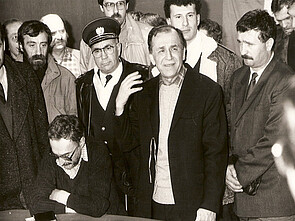
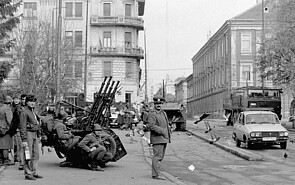
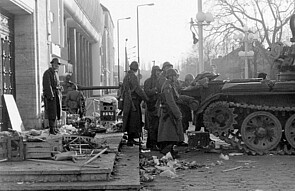
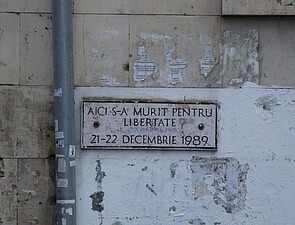
Lavinia Stan · 13.12.2019
The Băsescu Case: Romania's Lustration Debate Revisited
Read more
Monica Ciobanu · 19.02.2018
Criminals, Martyrs or Saints? Romania’s Prison Saints Debate Revisited
Read more
Oana-Valentina Suciu · 12.09.2017
'Lex CEU': Romanian Echoes and Trends
Read more
Bogdan C. Iacob · 07.05.2014
Romania - The Scramble for the Present: Making Sense of the Crisis in Ukraine
Read more
Gundel Große · 02.09.2013
Romanian Writers and the Securitate. Excerpts from a Debate
Read more
Get this article as PDF download (including pictures).